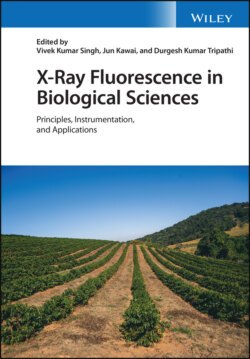Читать книгу X-Ray Fluorescence in Biological Sciences - Группа авторов - Страница 22
1.3.6 Proton‐Induced X‐Ray Emission (PIXE)
ОглавлениеPIXE technique involves the detection of X‐rays emitted from the sample due to the bombardment of the sample with high energy ions [3, 20]. Different types of excitation beams produce X‐rays with energies which are characteristic of the elements present in the sample. Electron excitation in an electron microprobe (SEM) gives rise to EDXRF or WDXRF, which depends on the X‐ray dispersion and detection mode. Charged particle beams of He2+ or H+ gives rise to PIXE spectroscopy. In all these spectroscopic methods, the excitation beam removes a core electron, which creates a vacancy, causing outer shell electrons to jump down to fill the inner shell vacancy. Thus, X‐rays are emitted with specific energies which are characteristic to the elements present in the sample. This accessory is very beneficial for identifying heavy elements by Rutherford backscattering spectrometry (RBS) [3]. These heavy elements show only small differences in RBS backscattered energies because of their similar masses, but there are distinct differences in their PIXE spectral studies. Being a non‐destructive analytic technique, PIXE offers signal levels similar to its electron beam counterparts, but provides better signal/background ratios. In electron spectroscopy, the background arises from bremsstrahlung and this is absolutely absent in PIXE due to the use of He2+ or H+ ions [3]. PIXE can analyze insulating samples which cannot be detected by electron‐induced spectroscopy. However, some limitations are also present, such as the analysis area is limited to 1–2 mm and useful information can be obtained to only ~1 μm depth of samples with good accuracy.
Recent developments in PIXE use tightly‐focused beams to enhance the ability of microscopic analysis. This technique is called micro‐PIXE [3, 21] and is used for determining the distribution of trace elements in a wide range of samples. A similar technique, particle‐induced gamma‐ray emission (PIGE) [3, 22] is used to detect some light elements. PIXE is a better method than the traditional XRF techniques as it can detect the elements and their ratio too. On the other hand, SRXRF is better than PIXE.
Table 1.3 Advantages and limitations of SEM‐EDS method [3, 8].
| Advantages | Limitations |
|---|---|
| Quick identification of elementsProvides high‐resolution imagingExcellent depth of field for 3D appearance of the specimen image ( ~100X that of Optical microscopy)Versatile platform and supports many other analytical techniquesPossibility of imaging of insulating and hydrates samples in low vacuum mode | Size restriction which requires cutting of the samplesNeed to etch planar samples for contrastUltimate resolution is a strong function of the sample chemistry and stability in the electron beam |
